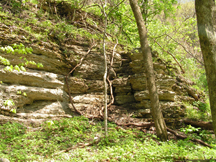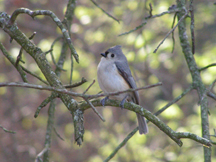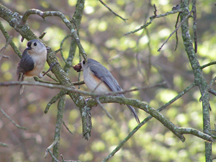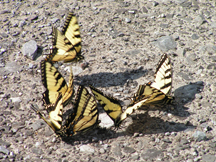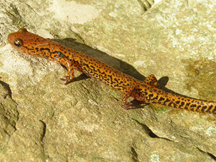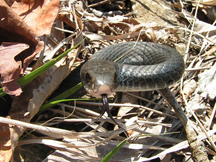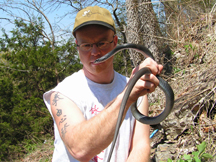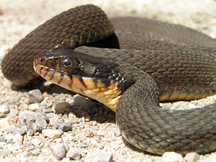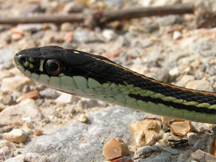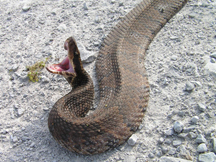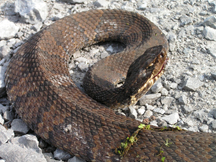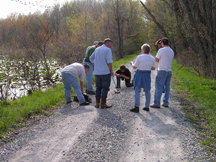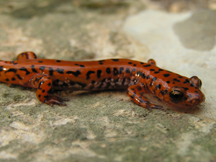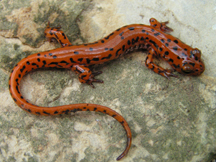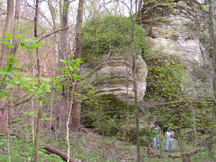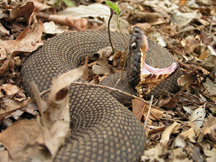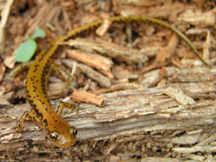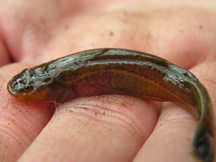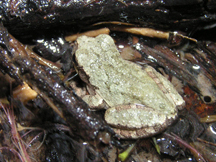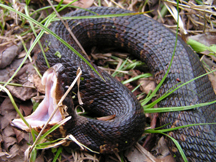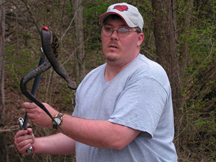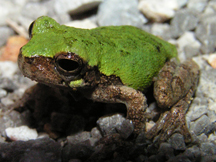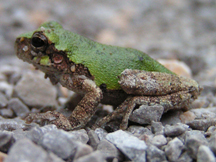
4-09-04
Trip Details
Herpers: Mike Pingleton, Jeff LeClere, Jim Scharosch & Matt Ricklefs
Location: Union County, Illinois.
Start Time: 7:00 am
Weather: Sunny. Low wind. High of about 70 degrees.
Quote of the day: “DANGER! – Falling Cottonmouths!”
This was our first day all together. We were glad to have Mike along and between the four of us we had a lot of hands and eyes for observation and documentation. We were back for day two on snake road. Mike was a true veteran of “the road”, so we followed along. In herping you really need to check your ego at the door. You need to rely on the strengths and experience of others when it applies and know that in discussion, your input is still valued. Such was the case here. Mike and Jeff not only had more experience with the area, but also with the fauna. Jim and I were glad to have the opportunity to learn. The day you think you know it all is the day you know the least. Mike also had gained a lot of knowledge about plants, insects, birds and nature in general from those he had been out with and we did our best to let it sink in. The morning was cool, around 50 – 55 degrees, but it was warming up fairly quickly. This day we had a few clouds, but it was shaping up nicely. We had gone to a few other spots with “junk” to start the day, but to our dismay, they were cleaned up. A good junk pile is hard to find anymore. It may be that herps don’t really need debris like this, but they certainly use it. It also makes them easier for us to find!
At about 10:00 am we were ready to walk to road. We stopped at the pond at the entrance to peek at the thousands of tadpoles we saw. They appeared to be Fowler’s Toad tadpoles (Bufo woodhousii fowleri) but we could not be absolutely sure. Jim saw a Tufted Titmouse and while taking some pictures of it, another one flew in, and handed the first one a seed and then flew off. The first one then started eating the seed.
It wasn't a herp, but if was fun to watch. We moved on.
Our next find was more akin to a forensic expedition. We had turned some old cement and found it to be a broken headstone. We had discovered an old grave plot with three headstones from what seemed to be for the “Walker” family. These dated back to 1937 as discerned from the time of death on the stones. Not herps again, but interesting nonetheless.
We started to find Eastern Zigzag Salamanders (Plethodon d. dorsalis) again with frequency. We also saw a lot of Yellow Swallowtail Butterflies.
As our “expertise” is with herps, we won’t try to play entomologist. We did appreciate the beauty of them, be assured.
Carrying on, Jim had mentioned that he hoped we found a Worm Snake. The species in the area is the “midwest” subspecies, but the “western” species is not too far away. Only a few steps after Jim had said this and Mike turns a rock and announces we have “filled the order”. Wow, if only it worked like that all the time.
We had a small one, but still we had our Worm Snake (Carphophis amoenus helenae). I will trust Conant/Collins in identifying this as the “midland” subspecies, although there is some room for variance as always. This one was about four inches long. Small snakes like these warm up quickly in your hand and often times pictures are better taken without a lot of handling as they are cooler and less mobile. This worked out pretty well and Jim got some great shots with his new digital camera. After a short time, it was under the rock and on its way.
Jeff made the next find. It was a nice Longtail/Dark-Sided Salamander (Eurycea longicauda melanopleura).
It was about four inches long. To mention again, the subspecies in this area is the Dark-Sided, but it is close to the true Longtail range. In the right areas, you can find many species of salamanders in a small area. It makes for a lot of fun. We took some pics and off we went.
We split up a little and did some heave duty climbing and turning. Jim did find a small Northern Fence Lizard (Sceloporus undulatus hyacinthinus) and was able to capture some photos of this one.
One thing to know is that if someone is in a rough or hard to reach area, and there is a chance to find something cool, and you are no where close, the find will be made. Jim had hiked quite a ways up and I was not far behind, but far enough to have to put in a good hike, when he shouted “racer!”. So up I went. And up. Then slid back a bit, then up to where he was. The opening was quite warm, as there was a full exposure to the sun. This is what Jim was counting on. It paid off. Jim had caught about a four foot long Black Racer (Coluber constrictor).
This is another species where there could be integration, but primarily this is the range of the “southern” subspecies. We do our best to capture species, subspecies and intergrades as accurately as we can. To compound this, there has been a lot of name changing going on. For example, there is a proposal to call the North American rat snakes Pantherophis instead of Elaphe. For now, we will do our best to keep up with these changes, but we will often times use old terms for ease of reference until there has been some more assimilation. We will make note whenever we can, such as this long ramble on. Now back to the racer. This particular racer was quite warm and was not in any mood to sit for a photo shoot. We needed to do the hold the tail trick and shoot the front part for a “natural” shot. After wrestling with this one for a while, we let it go on it way. Racers are very cool. In some areas where they are fairly common, you could possibly get lulled into appreciating them less. I don’t think we have though. We have found a fair share of different species, and always appreciate them. I’m sure this racer was happy we were not a hawk looking to eat him, although hawks usually do not lift rocks.
A good conversation that the four of us had was the topic of flipping rocks versus lifting rocks. We really don’t flip rocks, we lift them, and even if we don’t find anything we carefully place the rock, log, tin, etc. back the way it was. Thus Mike suggested the term lifting is more applicable to which we all concurred. This is just responsible herping. For “natural” objects such as rocks, logs and the like, you need to consider that there are many animals that call that home. It is part of the environment and keeping it like that keeps creatures there and/or encourages new ones to move in. Even debris such as tin and other “stuff” takes a while to settle down. You rarely find animals, especially herps, under new debris. So keeping things like you find them keeps “the environment” in a good state for all the critters around.
The herps we had found so far we had had to work for. We encountered quite a few people on the road and we wondered how this would affect our herping. We tried to space ourselves so we had some distance. It seemed not to matter too much. Not long after a group walked by, we found a water snake right to the side of the road. It was sitting tight and did not appear to have moved and the people appeared to have just missed it. This one was a Yellowbelly/Copperbelly Water Snake intergrade (Nerodia erythrogaster flavigaster x neglecta).
It was a small one at about thirteen inches long. These are really pretty. They have the slate to dark grey above with the yellow belly, but with a wash of light orange/pinkish down the middle. This one was behaving quite nicely and Jeff and Mike questioned, kiddingly, if it was near death. After a little handling, it acted more like you expect a water snake to act. Here again Mike and Jeff had a lot of information to share, being more familiar with this species/intergrade than Jim or I. It’s quite amazing when you can absorb information you are really interested in quite readily and retain it quite well. I’m sure there is information that my wife wishes I could retain as well as herp data. The water snake emitted some musk, and we thought the scent reminded us of Tsingtao, a beer from China. Of course Mike jokingly informed us that Tsingtao in Chinese means “malodorous serpent”. We do have a lot of fun. It is great when those you are around share a common sense of humor. It made for a great time. Of course we now were in the mood for a beer, but we still had some daylight left so on we went.
We reached the spot that Jeff and Jim had done so well with salamanders the day before and again we were not let down. We found Darkside/Longtails, the great “Shawnee green” Cricket Frog, and Bronze Frogs (Rana c. clamitans). There is so much to find down here and in so many phases. After looking around again for a while we documented and moved on.
The next “see” was a Western Ribbon Snake (Thamnophis p. proximus) out in one of the marshy areas. This one was too far out to capture, but soon after we had one in had from the side of the road that I managed to dive for. In this part of southern Illinois these can be identified as the western species, whereas a little further east is the eastern species.
The difference is in the parietal spots on the top of the head when present and/or defined. The western species has these touching, where the eastern species has these separated. Ribbons on first glance look similar to garter snakes, but upon close examination they are fairly different. They are really beautiful snakes. This one sat quite nicely for photos. There were some people coming so we held on to show them. They seemed mildly interested, but this would explain why some people miss or ignore some snakes. They are looking for the “big game”. They are looking for the timbers, cottonmouths, rats, kings and the smaller species go unappreciated and sometimes unnoticed. We look at them all and appreciate them. Not that we don’t really like to find “big game” especially on a slow day, but these smaller ones keep you going. They are all added to your life list also.
It was time for lunch. We went to a nearby town and I humored at the fire department’s name: The Ware-Wolf Lake Fire Dept. Funny. After our fill of quicky sandwiches and munches, we ventured back in to the road from the other direction.
We were not far in when Jeff spotted a Western Cottonmouth (Agkistrodon p. leucostoma) in the water not far from shore.
This was the first of the day. We got out and Jeff snagged it. It was a big one. It was a good three and a half feet long. The biggest we had found yet. We also had an audience. The people nearby marveled at Jeff seeing this one where it was. It was a good spot! We wrangled it to get some good photos and to allow the other people a chance to see and take photos also.
We did our best to educate these people that although dangerous and not to be messed with, this snake provided a unique part to the ecosystem that needed to be there. Hopefully it got through. This one was not very happy and it took a while to get it to calm down. I was videoing between the snake and the water and the suggestion was made to move “out of the line of escape” which I decided was good council. It finally went into “gape mode” and sat still for us. When we were done we let it go back to the water. It was trying to dig in so much under a log in the water that the buoyancy of its body kept bringing its backside up. This was pretty funny too.
We moved on further in. We found an area that Mike and Jeff knew where there were lower bluffs, with a spring creek running through. Upon walking up we found our next cottonmouth.
It was another juvenile and it was sitting in the water. It was really pretty. Not only was it in good shape but also between the juvenile color and the water washing it off, it was really bright. It also had a very pronounced yellow tail. It sat very nice for us. After some pics we decided to look for salamanders. We moved this little cottonmouth to a safe place for it and us and lifted rocks. Score: one Cave Salamander (Eurycea lucifuga) and one Longtail/Darkside (Eurycea longicauda x melanopleura). We took some pics of the Longtail, we then focused on the Cave Salamander. When not seen side by side, the two species can appear very similar in color. Obviously the Longtail does have a longer tail. But on closer inspection they are fairly different. Longtails are more yellow-orange with more spotting. Caves are much more solid bright orange with a little less spotting. Both are very pretty, but the “caves” are really gorgeous.
We took some pictures for a while, then something very peculiar happened…
There are not many times when one person is witness to a unique happening in nature. Sure, there are many things you can see, but we’re talking something really out of the ordinary. Fortunately there were four of us that saw this. We can swear to this. As we were taking pictures and wandering around the area looking for other things to document, we heard a rustling on the bluff/outcropping about twenty-five feet straight up. It could have been anything. I really expected to see a turkey peer over the ledge and high tail it the other way when it saw us or take flight and light on the next ridge. This was not the case. The rustling stopped and stuff fell down. Some of us saw sticks and there was some debris, but Mike saw something else. He saw a twenty inch long Cottonmouth!!! For whatever reason this snake fell off a thirty foot bluff, and had to suffer the humility of falling fifteen feet from four herpers. “Oh the humanity!” In the picture below, the center bluff is the the bluff if fell from. It fell from the brush on top of the bluff and landed on the ground where Jeff and Mike are standing.
Needless to say it was not very happy and went into “gape mode” pretty quick. It did not seem the worse for wear from the fall.
We decided not to mess with this poor snake too much as it had been through enough. We did get some pics and watched as it went about its way almost as if it meant to do that and knew it wanted to go this way. There were comments about the extreme nature of this particular snake. There were comments on the evolution of flying snakes and how this one was on the “cutting edge” for the species. Of course we all mentioned that perhaps we need a sign there now: “DANGER – Falling Cottonmouths!” This is something we will tell for years and years and years to come. People may doubt it, but I’ll tell you it’s the truth!! You can check Mike’s site also for his account of this event and other notes from this trip when he gets them posted. Mike has a great site and this is a good spot to mention that if you haven’t been there yet, check it out.
While we are at it, our other herping partner this day, Jeff LeClere, has a site on the herps of Iowa and one on the herps of Minnesota that are great!
We did see another Cave Salamander in the rocks about at eye level. This was very cool and looked like you would expect for something called a Cave Salamander. We could not get any good pics though, as it was dark and at a bad angle. This was still a good spot by Mike. We captured some more photos of the Cave Salamander we had found before and watched the “flying” cottonmouth move around. Jim then found a nice Longtail salamander that posed nicely for a photo.
We then headed on. It was getting late, but we still had some time left. Not much could top this event, so we carried on with low expectations.
We walked up the road to complete a full look at the three mile stretch. We did find a very peculiar fish that we took some pictures of, but we were unable to identify the species.
We also found a young Grey Treefrog (Hyla versicolor).
This was a nice addition. It was harder to take pictures and video as it was getting darker but we did get some. Then we found another cottonmouth going from a small marshy area to a larger area of water.
This one was also in good shape. Jim had spotted this one. It had a particularly white or “cotton” mouth. It was about twenty inches long as well. This one also had good color and being wet helped bring the colors out. We had got our fill of cottonmouths. As one of the “big game” we had hoped to find, we could not complain.
It was getting near twilight so we headed back to the truck. On the way back we found another treefrog. This one we identified as a Bird-Voiced Treefrog (Hyla avivoca).
It looked very similar to the Grey, but this one had a lot of green on its back. We did talk about the presence of green on both treefrogs and it can be very variable. This is not an indicator of what species are what, as both could have green to varying degrees. Both of these were about one inch long. “Greys” can be identified by the bright yellow/yellow-orange on the inside of the back legs. Bird-Voiced can be identified by the light green coloration on the back of the thighs and the lack of yellow. Both were very cool. This again was a chance for Mike and Jeff to share their expertise. We had found Grey’s before, but not Bird-Voiced. After a little wile we found a second Bird-Voiced Treefrog. This one had no green on its back. It was too dark to take photos now, but we did manage to get some video and away we went.
This was to be the last find of the day. It had been quite a day. We relived the falling cottonmouth story and discussed why we thought it had fallen. We will never know for sure, but it’s fun to guess. We went back to town. Our goal now was to find the Chinese restaurant we saw on the way out and see if water snake does indeed smell like Tsingtao. They didn’t have the beer, but the food was pretty good and we were ready to take it easy and prepare for the next day.

